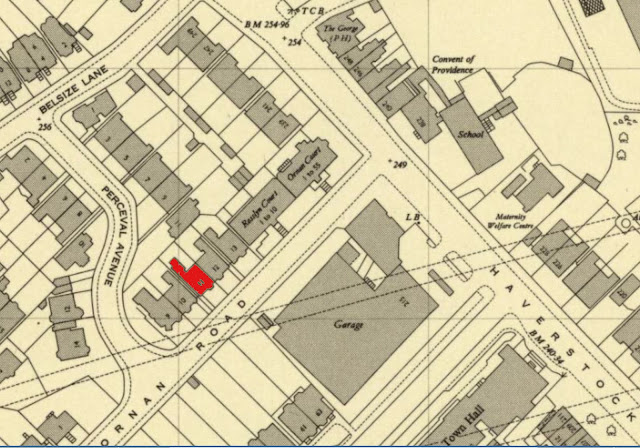From 1915 the well-known actor-manger Gerald Lawrence lived at 11 Ornan Road Haverstock Hill. He had a distinguished stage career as a Shakespearian actor and had worked with Sir Henry Irving. The handsome Lawrence appeared in several silent films such as ‘Captain Nighthawk’ (1914).
Gerald toured in South Africa and America and in 1906 he married the American actress Fay Davis. Their daughter Marjorie Fay Lawrence was born in 1908, when they were living at 15 Gardnor Mansions Church Row in Hampstead.
 |
| Gerald and Fay in Romeo and Juliet, 1909 |
Marjorie wanted to try acting, so in June 1930 Gerald staged ‘The Merchant of Venice’ and ‘Hamlet’ at the Embassy Theater in Swiss Cottage and Marjorie received praise for her performances. On Sunday 6 July 1930 Gerald Lawrence and his family were at home in Ornan Road. About 11.00 in the morning his daughter received a telephone call from her husband Eardley Cottrell saying he was coming to the house.
About 1.30 Gerald heard what he thought was the sound of the blinds tapping against the window on the first floor. He and his wife went downstairs to the drawing room and to their horror they found Marjorie lying on the floor with blood on her face. Gerald felt her pulse and she was not breathing. Her husband Eardley was lying unconscious next to her with a small pistol beside him. He was taken to Hampstead General Hospital where he died without regaining consciousness.
What lay behind this tragic event?
In 1925 Marjorie had fallen in love with Eardley when she was 17. Gerald and his wife Fay were opposed to a marriage and Marjorie and Eardley did not see each other for several years. Then they married on 26 July 1929 and travelled together in Europe. Eardley was an engineer with the Gramophone Company at their factory in Hayes. For his work he travelled from Vienna to Albania where they decided Marjorie would not be safe, and she returned to live with her parents in April 1930. When they had finished their work Eardley and a work colleague returned to England on Sunday 6 July and he booked into a room at the Great Eastern Hotel in Liverpool Street. Then he went to see Marjorie because he had not received any news from her for three weeks.
At the inquest, their letters showed Marjorie had decided the marriage was not working and she wanted to live apart from Eardley, but he was still very much in love with her.
In one letter he wrote;
‘To you who in spite of everything, I love better than anything on earth. I have suddenly realized that there is no one else but you. I have a funny feeling that one has no resting place to go. It is rather like going along a road and looking back. It has hurt me terribly, more than I can imagine. I have lost all that I wanted, dearest.’
On the 31 May he wrote from Albania:
‘God only knows how I got through yesterday or shall today till your telegram arrives. If your telegram says you will not give me another chance, there is only one way out for me. Yesterday I bought a pistol because in Albania we carry our lives in our hands. But I will use it on nobody but myself. Dear, send me that telegram that all is not finished. It means life or death to me. If you won’t come to me then I have finished. I can’t live without you.’
The inquest jury decided Eardley had murdered Marjorie and then committed suicide while ‘of unsound mind’.
 |
| Newspaper photos of Marjorie and Eardley |



Comments
Post a Comment